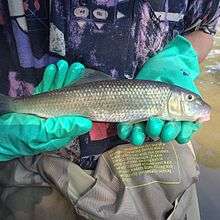Black redhorse
The black redhorse (Moxostoma duquesni, also duquesnii, duquesnei) is a species of freshwater fish endemic to Ontario and the eastern half of the United States, where it lives in streams and small to medium rivers.
| Black redhorse | |
|---|---|
 | |
| Black redhorse in the Huron River, Ohio | |
| Scientific classification | |
| Kingdom: | Animalia |
| Phylum: | Chordata |
| Class: | Actinopterygii |
| Order: | Cypriniformes |
| Family: | Catostomidae |
| Genus: | Moxostoma |
| Species: | M. duquesnei |
| Binomial name | |
| Moxostoma duquesnei (Lesueur, 1817) | |
| Synonyms | |
| |
A bottom-feeder, it feeds on microcrustaceans, aquatic insects, detritus, and algae. The black redhorse spawns in the spring.
This species has been identified as Threatened by the Committee on the Status of Endangered Wildlife in Canada (COSEWIC). It is currently being considered for listing under the federal Species at Risk Act (SARA).
Description
The black redhorse is a species of the sucker family, Catostomidae. It is laterally compressed and has a shallow body shape with little arching to the back. Nearly half of the head is a long, rounded snout. The mouth is on the underside of the snout and has a thick lower lip. The body is silvery-blue with a gray or brownish dorsal surface and silver or white belly. Some of the scales have dark edges. During the breeding season males have dark stripes and orange or pink coloration along the flanks, and develop nuptial tubercles on the tail fins.[2]
The black redhorse can be distinguished from similar species by the lack of red on the tail and the lack of grooving on the lips.[2]
Distribution
The black redhorse has a wide, but disjunct, distribution in eastern North America. It is found from Alabama and Mississippi in the south to Ontario and Michigan in the north, and from New York in the east to Oklahoma and Minnesota in the west. In Canada, it is limited to southwestern Ontario where it occurs in only six watersheds. In the Lake Huron drainage, it is found in the Bayfield River, Maitland River and Ausable River watersheds. In the Lake Erie drainage, it is known from the Catfish Creek (extirpated) and Grand River watersheds. It is also present in the Thames River watershed in the Lake St. Clair drainage.
Habitat and life history
The black redhorse usually lives in moderately sized rivers and streams, 25 to 130 m wide, up to 1.8 m in depth, and with generally moderate to fast currents. It is rarely found associated with aquatic vegetation. Substrates include rubble, gravel, sand, boulders and silt. In summer, they generally prefer pools and overwinter in deeper pools. In the spring, black redhorse migrate to spawning habitats. Spring spawning has been observed in riffle habitats at water temperatures between 15 °C and 21 °C, and over a variety of substrates from fine gravel to large cobble. Eggs are nonadhesive and range in size from 2.6 to 2.9 mm. The age at maturity is between two and six years. Lifespan increases with latitude and some individuals reach 16 years of age.
Diet
Adult black redhorse are bottom feeders and eat crustaceans and insects. The younger fish (less than 65 mm) are thought to prefer plankton.
Relationship with humans
Habitat may be altered or impaired through urbanization and agricultural activities that increase siltation, turbidity, and change flow regimes. The availability of suitable habitat limits the distribution of the black redhorse in Canada, rendering its distribution highly fragmented. Its restricted spawning habitat preferences make recruitment vulnerable to changes in flow regime. Dams and impoundment of riverine habitats also restrict movements of fish. Incidental catches of black redhorse by sport fishers have been reported and may impact populations. The IGFA world record for the species stands at 2lb 4oz caught from Franklin Creek in Franklin, Pennsylvania in 1998.[3]
References
- NatureServe. 2013. Moxostoma duquesnei. The IUCN Red List of Threatened Species 2013. Downloaded on 06 August 2018.
- COSEWIC Assessment and Status Report on the Black Redhorse Moxostoma duquesnei in Canada - 2015.
- "Redhorse, black". igfa.org. International Game Fish Association. Retrieved 17 May 2019.
External links
- "Moxostoma duquesnei". Integrated Taxonomic Information System. Retrieved 6 June 2006.
- Froese, Rainer and Pauly, Daniel, eds. (2005). "Moxostoma duquesnei" in FishBase. November 2005 version.
- NatureServe. 2018. Moxostoma duquesnei. NatureServe Explorer Version 7.1. Accessed: August 6, 2018
